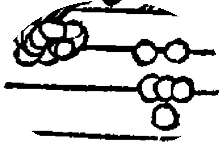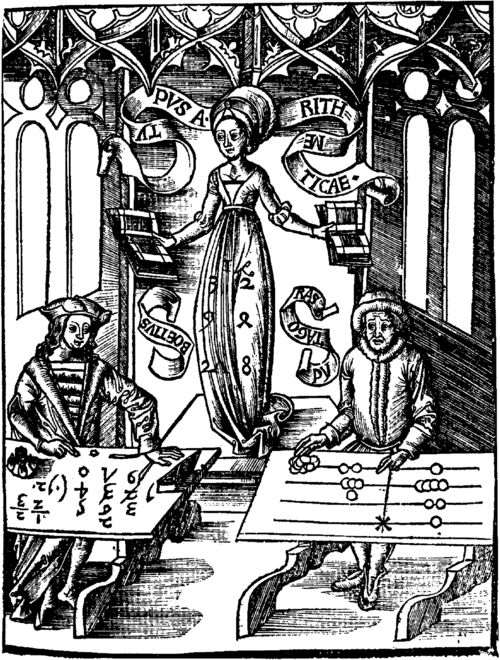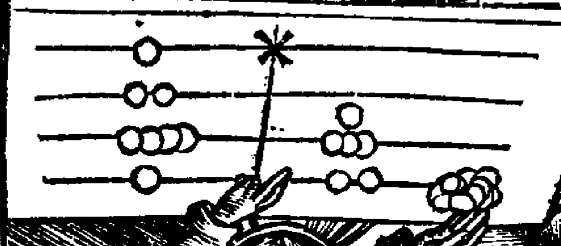JF Ptak Science Books Post 1512

This is a short note on the blank nature of the "checkers", the place-holders, the missing numbers, of ancient computing machines, the counters (jetton, or jeton1) used in early/ancient arithmetical reckoners, the material pieces used to aid in addition and multiplication "devices". These bits were sometimes pebbles or shards of pottery or rocks, and placed on the ground with a grid drawn in dust, or in sand, or on any surface that could hold a line. There are fancier and more permanent types of these instruments, as we see in the right side of this iconic woodcut image from a 1503 universal compendium of knowledge--a simple wooden table with incised counting lines, with the jettons being blank disks.
The book that this beautifully-illustrated counting board is found is in Gregor Reisch's Margarita Philosophica, and depicts (amidst much else in the greatly humanist volume) representations of the mathematicians Boethius and Pythagoras working math problems on the given tools of their day. (The Reisch book is remarkable: it is basically a Renaissance encyclopedia of general knowledge, divided into twelve books: grammar, dialectics, rhetoric, arithmetic, music, geometry, astronomy, physics, natural history, physiology, psychology, and ethics.) We can see in his expression that Boethius, on the left, is rather enjoying himself, knowing the superiority of his system of counting, which was the the Hindu-Arabic number notation--he definitely has a sly, self-appreciating smile on his face. Pythagoras, working with the old counting table, definitely looks worried, or at least unhappy, unsettled. Never mind that Pythagoras (570-495 b.c.e., none of whose works exist in the original, another sort of entry in our Blank History category) was at a definite disadvantage in the calculating department, being dead and all that for hundreds of years before the Arabic notation was more widely introduced in the West, probably being introduced by Pisano/Fibonnaci in the 12th century. But it does fall to Boethius, the smirker, to have introduced the digits into Europe for the very first time, deep into the history of the Roman Empire, in the 6th century.
The numerical stand-ins in the Reisch book with which Pythagoras worked were blank, coin-like slugs used as placeholders, and would be used in place of rocks or pebbles or whatever other material was at hand. It is interesting to note that the Latin expression, "calculos ponere", which basically means "to calculate"or "to compute", is more literally translated into "to set counters" or "to place pebbles" (upon a counting board) or to set an argument2, which is exactly what some of the Roman daily reckoners would do at their work. And also used, in this case, by the unhappy Pythagoras.
Here's a small close-up of the blanks:

The problem that the Pythagoras-person was working on (flipped 180 degrees) shows him adding the numbers 1241 and 82. A jetton occupying the the top of the mark on the counting board, counting as one unit of 1000; followed by two units of hundreds; four tens; 2 on the ones. The other number interestingly keep one jetton in between two lines, signifying an easy wade of enumerating 5 of any one kind, in this case depicting 8 tens units, coupled with two ones., thus making the number 82.)
For an excellent explanation of the many and varied methods of ancient calculations see the article by Steve Stephenson3 on how ancient computers worked, found in the IEEE Global History Network site, here.
It is a simple observation, but interesting to me nevertheless, that there was so much about these early counting systems that even though extremely useful they were also highly ephemeral--the counting boards being inscribed in dust or sand or dirt, the counters/numerical placeholders being blank disks or pebbles or pottery shards--and so so much of the counting world depended on so little.
Notes
1. I should point out that these markers seem to have been decorated more often than not--its really just those items that appear in the Reisch book that I am addressing. On jettons, in general, see here ; also, Jetons, Their Use in History.
2. See Jen (1998, April 25). "Roman Counting Instruments", in The Math Forum at Drexel University. Also see Karl Mennigner's (1969) Number Words and Number Symbols: A Cultural History of Numbers, a big, academic/coffee table book on the history of numbers. Also in general, see: Barnard, Francis Pierrepont, (1916). The Casting-Counter and the Counting-Board, A Chapter in the History of Numismatics and Early Arithmetic. Oxford University Press, London.
3. This is a deep and nicely-explained effort looking at the development and different sorts of these instruments, as well as how they functioned. Regarding the Reiwch woodcut, Stephenson says:
- Pythagoras has his abacus oriented with a vertical median line;
- The lines are equally divided so the same number of jettons can be accommodated on either side of the median line;
- The top horizontal line is marked with an X, (perhaps) to indicate the unit line; and
- On the right side of the abacus is a jetton in a space, all other jettons are on horizontal lines.
On pp.313-314, Prof. Barnard describes and quotes from Legendre, François, 1753. L'Arithmétique en sa perfection, Paris, pp. 497-528, Traité de l'arithmetiqué par les jetons:
It was permissible to set and to work the jettons of the sum without using the spaces [between lines], ... But it was much more convenient to anyone who was expert at the practice, and less confusing to the eye, to reduce the number of jettons by using the spaces.




Your article reminded me of even more ancient calculating methods that were precursors to the abacus. I saw some extensive web documentation of these calculators made from rope, but alas I could not find that page. So I'll give this link as a tantalizing glimpse of what is out there.
http://incas.homestead.com/quipu/quipu_video_elearning.html
Posted by: Charles | 13 June 2011 at 10:48 AM